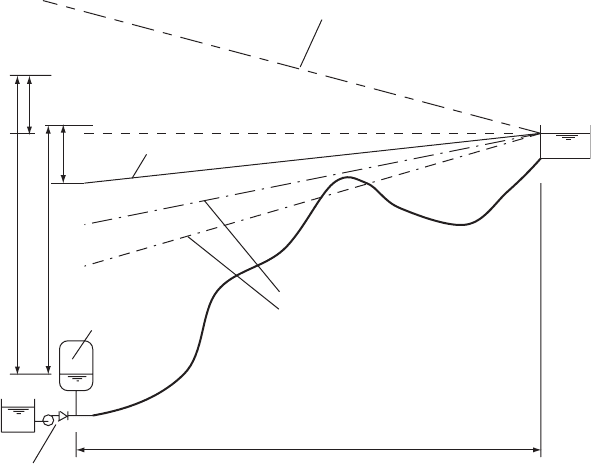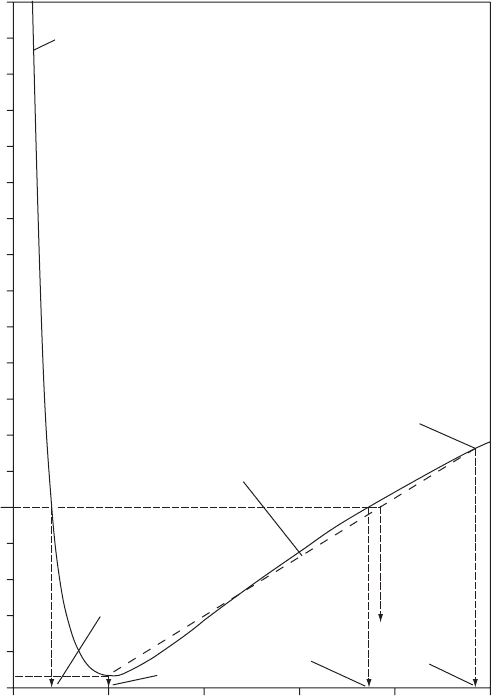Ellis,J. Pressure transients in water engineering, A guide to analysis and interpretation of behaviour
Подождите немного. Документ загружается.


h
abs
¼ atmospheric pressure head metres water
h ¼ the absolute pressure head in the vessel metres water
z ¼ d/s reservoir level pressure vessel level þ h
abs
ðmÞ
¼ density of water ðkg=m
3
Þ
g ¼ acceleration due to gravity ðm=s
2
Þ
L ¼ length of pipeline (m)
D ¼ pipe diameter (m)
A ¼ cross-section area of pipe ¼ D
2
=4
V ¼ velocity of flow ðm=sÞ
Vol ¼ gas volume in vessel ðm
3
Þ
F ¼ overall resistance factor ¼ fL=D þ
X
K
L
Suffixes:
o ¼ initial steady flow rate
m ¼ minimum head condition
p ¼ peak head condition
202
M
M
h
abs
h
abs
z
h
Pum
p
in
g
station
Maximum allowable hydraulic gradient
Transient hydraulic gradient
Gas volume = Vol
Minimum hydraulic gradient:
no vacuum allowed
vacuum allowed
Pipeline length = L and diameter = D
Fig. A12.1. Definition sketch for simplified vessel analysis
Pressure transients in water engineering
With reference to Fig. A12.1, the minimum acceptable head h
m
at
the pressure vessel during the downsurge after pumping failure is
obtained by drawing a straight line from the downstream reservoir to
the pressure vessel location, such that at no point along the line is
head less than the prescribed minimum. The atmospheric pressure
head h
atm
is added to the gauge pressure head to give the minimum
allowable absolute pressure head. If treated water is being carried
then the minimum acceptable head should remain positive, say at
least þ1 m above ground level. If sub-atmospheric pressures are accep-
table then this minimum head line will be lower as illustrated.
Mass of water in the pipeline ¼ AL
Acceleration of water column ¼ dV=dt
Force acting ¼ gAðh zÞ
Force due to flow resistance ¼FV
2
=ð2gÞgA
Since force ¼mass and acceleration,
gAðh zÞ¼AL dV=dt FV
2
=ð2gÞgA
simplifying
L=g dV=dt FV
2
=ð2gÞ¼h z ð2:1Þ
A12.2 Solution ignoring resistance to flow
Considering a frictionless pipeline in the first instance, then,
L=g dV=dt þ z h ¼ 0
or
L=g dV=dVol dVol=dt þz h ¼ 0
but
dVol=dt ¼ AV
therefore,
L=gAV dV=dVol þ z h ¼ 0
or
LA dðV
2
=2gÞ=dVol þ z h ¼ 0 ðA12:1Þ
203
Pressure vessels
where LA ¼ V
p
is the pipe volume and V
2
=ð2gÞ¼e is the kinetic
energy of flow. The absolute pressure head h can be represented by:
hVol
n
¼ constant, or h ¼ constant Vol
ðnÞ
Substituting then,
V
p
de=dVol þ z constant Vol
ðnÞ
¼ 0
or
V
p
de þ z dVol constant Vol
ðnÞ
dVol ¼ 0 ðA12:2Þ
Integrating between the limits e
m
and e and Vol
m
and Vol then,
V
p
ð
de þ z
ð
dVol constant
ð
Vol
ðnÞ
dVol ¼ 0
or
V
p
ðe e
m
ÞþzðVol Vol
m
Þconstant lnðVol=Vol
m
Þ¼0
for n ¼ 1 ðA12:3aÞ
and
V
p
ðe e
m
ÞþzðVol Vol
m
Þ
constant=ð1 nÞðVol
ð1nÞ
Vol
ð1nÞ
m
Þ¼0 for n 6¼ 1
ðA12:3bÞ
Noting that e
m
¼ 0 and rearranging these equations, kinetic energy e
can be expressed as a function of changing volume Vol within the
vessel, thus:
e ¼fzðVol
m
VolÞþconstant lnðVol=Vol
m
Þg=V
p
for n ¼ 1
ðA12:4aÞ
and
e ¼fzðVol
m
VolÞþconstant=ð1 nÞ½Vol
ð1nÞ
Vol
ð1nÞ
m
g=V
p
for n 6¼ 1 ðA12:4bÞ
If the values e and Vol are taken as the initial steady flow conditions
represented by suffix o, equations (A12.4a) and (A12.4b) can be written:
V
p
e
o
þ Vol
m
zðVol
o
=Vol
m
1ÞVol
m
h
m
lnðVol
o
=Vol
m
Þ¼0
for n ¼ 1
204
Pressure transients in water engineering
and
V
p
e
o
þ Vol
m
zðVol
o
=Vol
m
1Þ
Vol
m
h
m
=ð1 nÞðVol
o
h
o
=Vol
m
h
m
1Þ¼0 for n 6¼ 1
The equations can also be arranged to allow solution for Vol
m
, noting
that for the frictionless case h
o
¼ z, thus,
Vol
m
¼ V
p
e
o
=fzð1 h
m
=zÞþh
m
lnðh
m
=zÞg for n ¼ 1 ðA12:5aÞ
and
Vol
m
¼ V
p
e
o
=fzð1 ðh
m
=zÞ
ð1=nÞ
Þþh
m
=ð1 nÞððh
m
=zÞ
ð1=n 1Þ
1Þg
for n 6¼ 1 ðA12:5bÞ
A12.3 Including resistance to flow
The incompressible flow equation includes the resistance term, giving:
L=g dV=dt FV
2
=ð2gÞ¼h z ð2:1Þ
or
V
p
de=dVol Fe þ z h ¼ 0
yielding
V
p
de Fe dVol þ z dVol constant Vol
ðnÞ
dVol ¼ 0 ðA12:6Þ
If it is assumed that the relationship between e and Vol follows a
similar trend as in the resistance-free case then the equation can be
written:
V
p
de F=V
p
fzðVol
m
VolÞþconstant lnðVol=Vol
m
ÞgdVol
þ z dVol constant Vol
ðnÞ
dVol ¼ 0 for n ¼ 1 ðA12:7aÞ
and
V
p
de F=V
p
fzðVol
m
VolÞ
þ constant=ð1 nÞðVol
ð1 nÞ
Vol
ð1 nÞ
m
ÞgdVol þ z dVol
constant Vol
ðnÞ
dVol ¼ 0 for n 6¼ 1 ðA12:7bÞ
Integrating the equation between the limits e
m
and e and Vol
m
and
Vol then the results are the same for all terms as for the resistance-
free case and only the resistance term need be considered.
205
Pressure vessels
For n ¼ 1 then the resistance term becomes:
F
ð
e dVol ¼F=V
p
z
ð
ðVol
m
VolÞdVol
þ constant
ð
½lnðVolÞlnðVol
m
ÞdVol
¼F=V
p
fz=2ðVol
m
VolÞ
2
þ constant½VolðlnðVolÞ1ÞþVol
m
Vol lnðVol
m
Þg
Writing constant ¼ Volh ¼ Vol
m
h
m
as appropriate then,
F
ð
e dVol ¼F=V
p
Vol
2
m
fz=2ð1 Vol=Vol
m
Þ
2
þ h
m
½Vol
2
h=ðVol
2
m
h
m
ÞlnðVolÞ
Vol
2
h=ðVol
2
m
h
m
Þþ1 Vol
2
h=ðVol
2
m
h
m
ÞlnðVol
m
Þg
By substituting ¼ h
m
=h for Vol=Vol
m
then the equation can be
written:
F
ð
e dVol ¼F=V
p
Vol
2
m
fz=2ð1 Þ
2
þ h
m
½1 þ ðlnðÞ1Þg
ðA12:8aÞ
For n 6¼ 1 the resistance term becomes:
F
ð
e dVol ¼F=V
p
z
ð
ðVol
m
VolÞdVol
þ constant=ð1 nÞ
ð
½Vol
ð1 nÞ
Vol
ð1 nÞ
m
dVol
¼F=V
p
fz=2ðVol
m
VolÞ
2
þ constant=ð1 nÞ½Vol
ð2 nÞ
=ð2 nÞ
Vol
ð1 nÞ
m
Vol þ Vol
ð2 nÞ
m
ð1 nÞ=ð2 nÞg
substituting Vol
ðnÞ
m
h
m
¼ constant then,
F
ð
e dVol ¼F=V
p
fVol
2
m
ðz=2Þð1 Vol=Vol
m
Þ
2
þ Vol
2
m
h
m
=ð1 nÞðVol
2
h=ðVol
2
m
h
m
Þ=½ð1 nÞð2 nÞ
Vol=Vol
m
1=ð1 nÞþð1 nÞ=½ð1 nÞð2 nÞÞg
206
Pressure transients in water engineering
also Vol=Vol
m
¼ðh
m
=hÞ
ð1=nÞ
¼
ð1=nÞ
giving:
F
ð
e dVol ¼FV
p
Vol
2
m
fz=2ð1
ð1=nÞ
Þ
2
þ h
m
ð1=ð2 nÞ
þ 1=ð1 nÞ
ð1=nÞ
½1=ð2 nÞ
ð1=n 1Þ
1ÞgðA12:8bÞ
A12.4 Complete equations
Including the resistance term the equation becomes:
For n ¼ 1:
V
p
e þ Vol
m
fzð 1Þh
m
lnðÞg þ Vol
2
m
ðÞF=V
p
fz=2ð1 Þ
2
þ h
m
ð1 þ ½lnðÞ1Þg ¼ 0 ðA12:9aÞ
and for n 6¼ 1:
V
p
e þ Vol
m
fz½
ð1=nÞ
1h
m
=ð1 nÞð
ð1=n 1Þ
1Þg
þ Vol
2
m
ðÞF=V
p
fz=2½1
ð1=nÞ
2
þ h
m
ð1=ð2 nÞ
þ 1=ð1 nÞ
ð1=nÞ
½1=ð2 nÞ
ð1=n 1Þ
1Þg ¼ 0 ð A12:9bÞ
A12.5 Application of the equations
A12.5.1 Maximum expanded gas volume
To calculate the maximum expanded gas volume Vol
m
after the initial
downsurge following a pumping failure, an explicit solution can be
obtained from the equation:
aVol
2
m
þ bVol
m
þ c ¼ 0
where
a ¼þF=V
p
fz=2ð1 Þ
2
þ h
m
ð1 þ ½lnðÞ1Þg n ¼ 1
or
a ¼þF=V
p
fz=2½1
ð1=nÞ
2
þ h
m
ð1=ð2 nÞþ1=ð1 nÞ
ð1=nÞ
½1=ð2 nÞ
ð1=n 1Þ
1Þg n 6¼ 1
where
b ¼ zð 1Þh
m
lnðÞ n ¼ 1
207
Pressure vessels
or
b ¼ zð
ð1=nÞ
1Þh
m
=ð1 nÞð
ð1=n 1Þ
1Þ n 6¼ 1
where c ¼ V
p
e
o
.
The value of ¼ h
m
=h
o
is obtained with h
o
being the initial steady
flow absolute pressure head in the vessel and z is the level difference
between the pressure vessel and the downstream reservoir þatmos-
pheric pressure head. Note that h
o
¼ z þ Fe
o
.
Example
Z ¼ 100 m, L ¼ 1000 m, D ¼ 1:0m,e
o
¼ 0:2, F ¼ 20, h
o
¼ 104 m and
h
m
¼ 20 m. V
p
¼ 785 m
3
and ¼ h
m
=h
o
¼ 20=104 ¼ 0:19231
n ¼ 1
a ¼ð32:618343 þ 9:8128514Þ20=785 ¼0:5810316
b ¼80:769231 þ 32:973173 ¼47:796058
c ¼ 785 0:2 ¼ 157
Vol
m
¼f47:796058
p
½2284:4632 4 ð0:581036Þ157g
=½2 ð0:5810316Þ
¼ 3:163 m
3
The corresponding result with zero friction is:
Vol
m
¼785 0:2=ð80:0 þ 32:188758Þ¼3:284 m
3
n ¼ 1:001
a ¼ð32:592745 þ 9:807059Þ20=785 ¼0:580527
b ¼80:737531 þ 32:968 ¼47:769531
c ¼ 157
Vol
m
¼f47:769531
p
½2281:9281 4 ð0:580527Þ157g
=ð1:161054Þ
¼ 3:165 m
3
n ¼ 1:2
a ¼ð27:891309 þ 8:661267Þ20=785 ¼0:4898135
208
Pressure transients in water engineering

b ¼74:687762 þ 31:62364 ¼43:064122
c ¼ 157
Vol
m
¼½43:064122
p
ð1854:5186 þ 307:60288Þ=ð0:979627Þ
¼ 3:5059 m
3
The corresponding result with zero friction is:
Vol
m
¼785 0:2=ð73:84679 þ 30:76605Þ¼3:6443 m
3
n ¼ 1:41
a ¼ð23:763877 þ 7:5740078Þ20=785 ¼0:4124807
b ¼68:940375 þ 30:004902 ¼38:935473
c ¼ 157
Vol
m
¼ð38:935473 42:130855Þ=ð0:8249614Þ¼3:873372 m
3
The corresponding result with zero friction is:
Vol
m
¼785 0:2=ð68:064289 þ 29:111493Þ¼4:031 m
3
Predictions of maximum expanded air volume have been assessed for
a range of different pumping systems. The following tables contain the
characteristics of some schemes (Table A12.1) and maximum gas
volumes estimated using the present equations and obtained from
detailed elastic analysis (Table A12.2).
A12.5.2 Peak upsurge pressure head
To calculate the peak return upsurge pressure head h
p
in the pressure
vessel, the value of V
p
e ¼ 0 since the reverse velocity has become
zero at the peak of the upsurge. Writing h
m
=h
p
¼ the equations
209
Table A12.1. System characteristics
Project Pipe
material
Diameter
(mm)
Length
(m)
Velocity
(m/s)
z
(m)
Head loss
(hf )
h
m
(m)
Kielder Steel 2000 6 170 2.010 207.70 5.000 123.700
New Aleppo DI 1400 12 500 2.057 106.70 21.180 50.890
Kurdaha DI 400 4 803 0.955 179.59 8.320 134.000
Shiskine PE 110 2 427 0.760 38.66 12.000 24.490
Haidaria DI 1000 1 225 1.415 53.80 1.470 30.172
Silverburn DI 300 3 150 0.854 68.59 6.162 38.355
Pressure vessels

become:
for n ¼ 1:
zð 1Þh
m
lnðÞþðFÞVol
m
=V
p
ðz=2ð1 Þ
2
þ h
m
½1 þ ðlnðÞ1ÞÞ ¼ 0 ¼ fnðÞðA12:10aÞ
and for n 6¼ 1:
zf
ð1=nÞ
1Þh
m
=ð1 nÞð
ð1=n 1Þ
1Þ
þðFÞVol
m
=V
p
½z=2ð1
ð1=nÞ
2
þ h
m
ð1=ð2 nÞ
þ 1=ð1 nÞ
ð1=nÞ
½1=ð2 nÞ
ð1=n 1Þ
1Þg ¼ 0 ¼ fnð Þ
ðA12:10bÞ
It is not possible to obtain an explicit solution for and it is necessary
to resort to an iterative solution. The form of fn() is as illustrated in
Fig. A12.2. The solution for h
p
is the smaller of the two values of .
At the turning-point d½fnðÞ=dh
p
¼ 0. For the resistance-free case
and with n ¼ 1 then,
Vol
m
zðVol=Vol
m
1ÞVol
m
h
m
lnðVol=Vol
m
Þ¼fnðhÞ
or in terms of h
m
=h and dividing throughout by Vol
m
,
zðh
m
=h 1Þh
m
lnðh
m
=hÞ¼fnðhÞ
Differentiating with regard to h,
d½fnðhÞ=dh ¼ zh
m
ð1=h
2
Þþh
m
=h
at a turning-point d½fnðhÞ=dh ¼ 0 so that,
z=h þ 1 ¼ 0orh ¼ z
210
Table A12.2. Gas volumes
Project Max. air volume,
detailed analysis
(m
3
)
Max. air volume,
estimated, n ¼ 0
(m
3
)
Max. air volume, estimated,
n ¼ 0, zero friction
(m
3
)
Kielder 180.00 188.000 200.600
New Aleppo 160.00 173.840 229.000
Kurdaha 4.10 3.700 4.400
Shiskine 0.10 0.140 0.225
Haidaria 14.00 14.900 15.890
Silverburn 0.73 0.873 1.040
Pressure transients in water engineering

The minimum value of h
p
¼ h
min
is set equal to z.
A maximum value of h
p
¼ h
max
can be obtained by assuming
h
m
=h 1, then,
z h
m
lnðh
m
=hÞ¼0
or
lnðh
m
=hÞ¼z=h
m
or h
max
¼ h
m
expðz=h
m
Þ
Initial values of are then obtained from
1
¼ h
m
=h
min
and
2
¼ h
m
=h
max
and corresponding values of fnð
1
Þ and fnð
2
Þ found.
211
65
60
55
50
45
40
35
30
25
20
15
10
5
0
–5
–
10
–
15
–
20
–
25
0 100 200 300 400 500
h
p
(m)
h
max
= 487.3
1st approx.
to h
p
fn'{x} = (fn{x
2
} – fn{x
1
})/(x
2
– x
1
)
fn(x)
z = 100.0
h
p
= 372.6
x
1
= h
m
/z
h
max
= h
m
exp{z/h
m
}
x
2
= h
m
/h
max
x = h
m
/h
p
h
m
= 40
Fig. A12.2. Curve of fn() plotted against h
p
Pressure vessels
